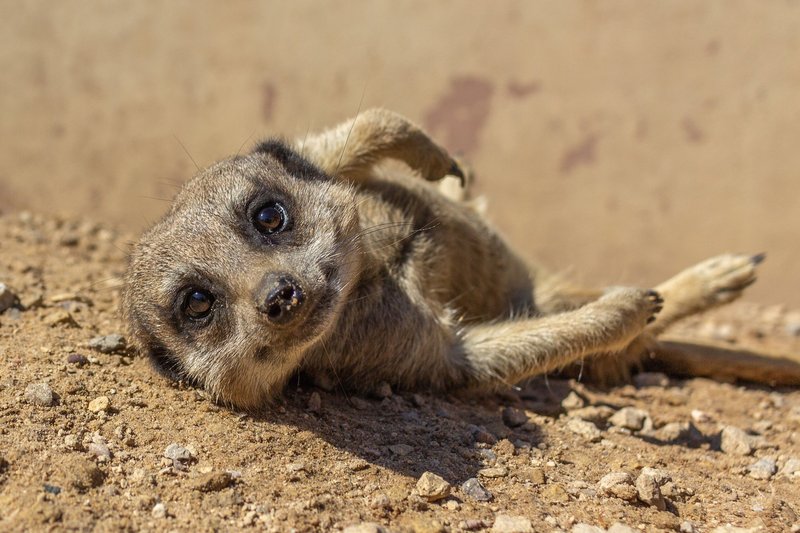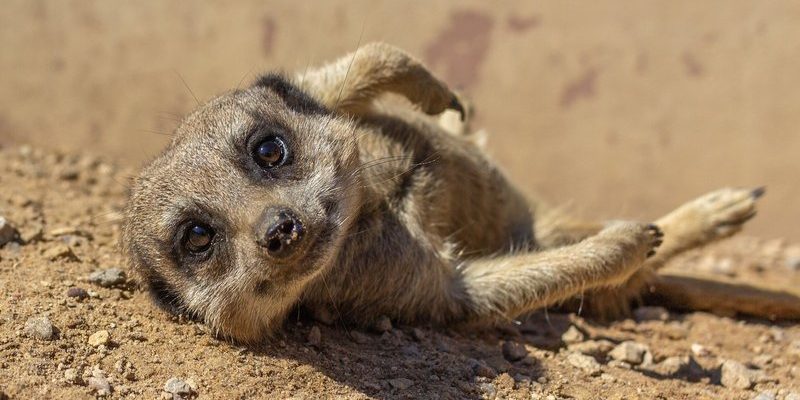
Imagine a tiny animal that looks like a cross between a squirrel and a little vigilante. That’s the meerkat for you! These small mammals, native to the southern regions of Africa, have become famous for their quirky behavior, particularly the way they stand on their hind legs while keeping a watchful eye for predators. Living in family groups known as mobs, meerkats have a fascinating social life that is as intricate as it is entertaining. If you’ve ever seen them in documentaries or zoos, you know these animals seem to have a knack for teamwork.
Meerkats are part of the mongoose family and are about the size of a house cat, though their slender bodies and cute faces definitely make them stand out. They thrive in arid and semi-arid regions, showing remarkable adaptations to survive in challenging environments. Not only are they visually captivating, but their behavior and lifestyle offer interesting insights into social animals and survival strategies.
Physical Characteristics
So, what does a meerkat really look like? Well, they have a slender build with a long body, short legs, and a pointed snout. Their fur is typically a sandy or light brown color with darker stripes on their backs, providing excellent camouflage in the dusty environments they call home. Adult meerkats usually weigh about 1.5 to 2.5 pounds, about the same as a loaf of bread. They can grow to be approximately 24 to 35 inches long, including their tails, which are almost as long as their bodies!
Their large, dark eyes and expressive faces give meerkats a unique charm. These eyes are perfectly suited for detecting movement in the wild. This is crucial for spotting predators like eagles, snakes, and jackals. And let’s not forget their sharp claws, which help them dig for food, such as insects, worms, and even roots. These adaptations not only assist in foraging but are essential for creating their underground burrows.
Habitat and Distribution
Meerkats are primarily found in the Kalahari Desert and surrounding regions, including parts of Botswana, Namibia, and South Africa. They prefer open areas with sparse vegetation, which allows them to spot predators from a distance. You might think such a harsh habitat would be difficult for them, but meerkats have adapted incredibly well.
They live in complex burrow systems that can span over a mile, providing shelter from the intense heat of the day and protection from predators. These burrows are a remarkable feat of engineering. They help regulate temperature, making life more comfortable for the meerkat mob. The intricate maze of tunnels includes separate chambers for sleeping, nurseries, and even toilets, showing just how organized these little creatures can be.
Diet and Feeding Habits
What do meerkats eat? These little foragers are primarily insectivores, meaning they love to munch on bugs! Their diet mainly consists of beetles, grasshoppers, and termites. However, they also enjoy other tasty snacks like small rodents, birds, and even some plants or fruits when available. Due to their semi-nomadic lifestyle, meerkats often forage in different areas for food, which enhances their foraging skills.
Meerkats have a fascinating feeding behavior. They take turns foraging, with one member of the mob acting as a lookout to watch for any danger while others dig for food. This cooperation is vital for their survival and allows them to maximize their foraging efficiency. It’s a beautiful example of how teamwork in the animal kingdom can lead to better outcomes.
Social Structure and Behavior
Meerkats are incredibly social animals, living in family units called mobs, which can range from 20 to 50 individuals. Within the mob, there is a strict hierarchy, usually led by a dominant breeding pair. This pair is responsible for most of the breeding, while other members help rear the young. You might think that this sounds a bit unfair, but it’s actually very effective!
Communication is key in meerkat society. They use various vocalizations to convey messages, including alarm calls to warn about potential predators. Their social structure is fascinating—when one meerkat is on lookout duty, they use different sounds to inform their group members about who is approaching and from which direction. This intricate communication system helps keep the mob safe while foraging.
Reproduction and Lifespan
When it comes to reproduction, the dominant female in a meerkat mob is the only one that typically breeds. After a gestation period of about 11 weeks, she gives birth to a litter of 2 to 5 pups. These pups are born blind and helpless, relying entirely on their parents and other mob members for care. As they grow, they begin to explore their surroundings and join in the mob’s activities.
Meerkats generally have a lifespan of 6 to 7 years in the wild, though they can live longer in captivity. The dangers in the wild, like predators and harsh conditions, contribute to their shorter lifespan. Still, the bonds they form within their mob are strong, and they often work together to raise the young and ensure the safety of their family unit.
Fun Facts about Meerkats
- Unique Behavior: Meerkats often stand on their hind legs to survey their surroundings—a behavior known as “sentinel duty.” This posture helps them keep a lookout for threats.
- Dietary Variety: While they love insects, meerkats are not picky eaters. They’ll also snack on fruits, vegetables, and even small reptiles whether they’re hungry!
- Complex Communication: Meerkats have about 25 different vocalizations, each serving a specific purpose, from warning of danger to signaling the presence of food.
- Community Helpers: In their mobs, meerkats often take turns babysitting and caring for the young while others forage for food.
Conservation Status
According to the IUCN Red List, meerkats are classified as Least Concern. While they face threats from habitat loss and poaching, they are still relatively abundant in their native regions. Conservation efforts are focused on protecting their habitats and ensuring that their populations remain stable. In recent years, eco-tourism has also played a significant role in raising awareness about these charming creatures and the ecosystems they inhabit.
By supporting conservation efforts and protecting their habitats, we can help ensure that future generations will enjoy watching meerkats thrive in the wild. After all, these delightful animals not only bring joy to those who encounter them but also play a crucial role in their ecosystem.
FAQ
What do meerkats do to protect themselves from predators?
Meerkats are well known for their cooperative behavior when it comes to watching out for danger. One or two members of the mob will take turns standing as sentinels, scanning the surroundings for predators like birds of prey and snakes. They use alarm calls to alert the group, giving everyone time to escape or hide. Their burrows also provide an excellent refuge from threats, allowing them to quickly retreat when in danger.
Are meerkats good pets?
While meerkats are undeniably cute, they are not ideal pets. They require a complex social structure and a lot of space to roam, which is difficult to provide in a home environment. Additionally, they have very specific dietary needs and behaviors that can be challenging to meet. It’s best to enjoy meerkats in their natural habitat or in a quality zoo setting where they can thrive properly.
How do meerkats raise their young?
In meerkat mobs, all members contribute to raising the young. The dominant female usually gives birth to the pups, but other adults help care for them. They take turns babysitting, which allows the mother to forage for food. This communal parenting approach increases the survival rate of the young and strengthens the bonds within the mob.
What are some of the meerkat’s natural predators?
Meerkats are small and vulnerable in their environment, making them targets for several predators. Their main threats include birds of prey, like eagles and hawks, snakes, and larger mammals such as jackals. This is why their lookout behavior and quick escapes into burrows are so vital for their survival.
Can meerkats see well at night?
Meerkats are primarily diurnal, which means they are most active during the day. They have excellent vision during daylight hours, but their night vision is not as strong. As a result, they tend to rest at night and are less active after sunset. This helps them conserve energy and stay out of harm’s way.
What is a meerkat’s social structure like?
The social structure of meerkats is quite fascinating. Mobs are typically led by a dominant mating pair, while other members help raise the pups and forage for food. This hierarchical system ensures that the mob runs smoothly and efficiently, with roles clearly defined. However, there is also cooperation among all members, which helps forge strong relationships and promotes group survival.
How do meerkats communicate with each other?
Communication is vital for meerkats, and they use various vocalizations to convey different messages. They have alarm calls to warn about predators and other sounds to signal food sources and give directions to group members. Their ability to communicate effectively enhances their teamwork and contributes to their survival in the wild.
Do meerkats hibernate or enter a state of dormancy?
No, meerkats do not hibernate or enter a state of dormancy. Instead, they remain active year-round. They are adapted to their environment and can endure extreme temperatures, using their burrows to escape from the heat during the hottest parts of the day. This active lifestyle helps them forage and engage in social behaviors throughout the year.
How fast can meerkats run?
Meerkats can reach speeds of up to 30 miles per hour when sprinting. This agility is crucial for evading predators and navigating the rugged terrains of their natural habitat. They are quick on their feet, which helps them survive in an environment where every second counts.
What is the lifespan of a meerkat in the wild?
In the wild, meerkats typically live around 6 to 7 years. However, they may live longer in captivity, sometimes reaching up to 12 years. The lifespan is affected by various factors, including predation, habitat conditions, and access to food. Survival rates are often higher in well-structured social groups like those found in mobs.
Are meerkats endangered?
Meerkats are currently classified as Least Concern on the IUCN Red List, indicating that they are not endangered. However, they do face threats from habitat loss and poaching. Continued conservation efforts and habitat protection are essential to ensuring that their populations remain stable and that these charming creatures continue to thrive in their natural environments.

